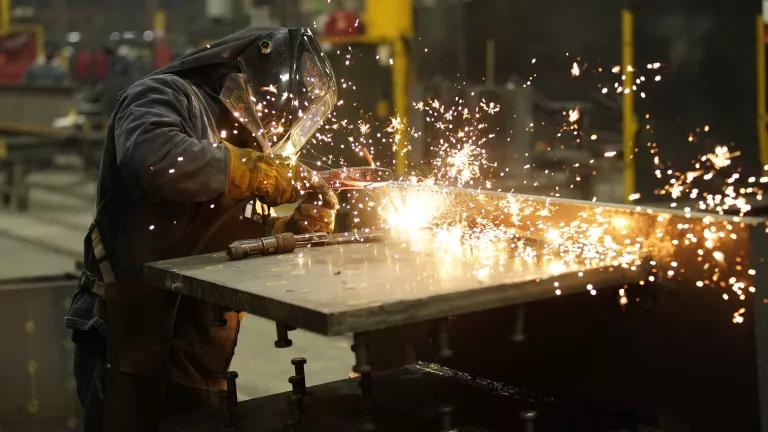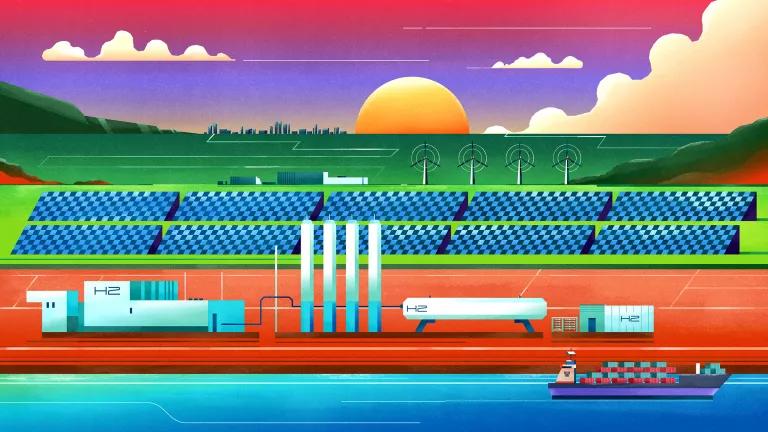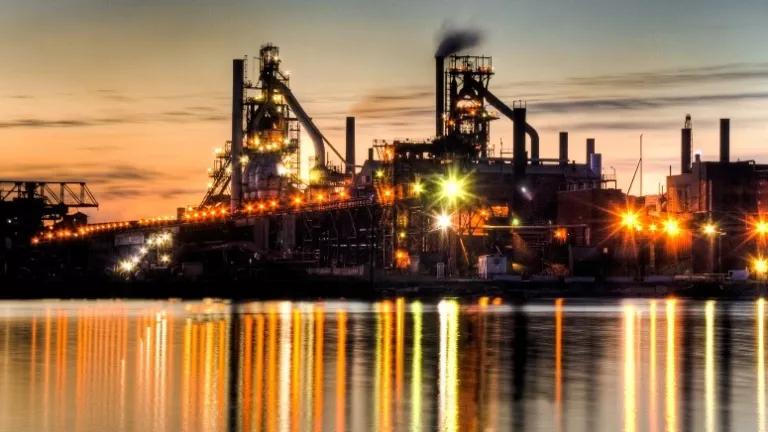Paving the Way to Industrial Decarbonization
Additional funding is needed to reach net zero in the industrial sector by 2050.

George Frey/Bloomberg via Getty Images
From highways to wind turbines to electric vehicles, industrial materials like steel, cement, and aluminum are foundational to everyday life and the clean energy transition. However, industrial manufacturing is extremely emissions intensive. In 2021, the industrial sector accounted for 23 percent of U.S. greenhouse gas (GHG) emissions. As other sectors take steps to reduce their emissions, the industrial sector could rise to 27 percent of total U.S. GHG emissions by 2030, making it the largest source of domestic emissions.
While new landmark legislation has enabled the industrial sector to start taking the critical first steps that are necessary to decarbonize, the Bipartisan Infrastructure Law (BIL) and Inflation Reduction Act (IRA) funding alone will not get the industrial sector to net zero by 2050. NRDC’s issue brief “Paving the Way to Industrial Decarbonization” calculated the size of the funding gap and found that we will still need approximately 5 to 10 times more funding, anywhere between $557 billion and $995 billion in combined public and private funding, beyond what the BIL and IRA will generate, if we are to decarbonize in line with our 2050 goals.
According to the U.S. Department of Energy’s (DOE) Pathways to Commercial Liftoff: Industrial Decarbonization report, the industrial sector will need $700 billion to $1.1 trillion in combined private and public sector investments to align this sector with net zero goals by 2050. After looking at 13 key buckets of funding from the BIL and IRA, we calculated that current BIL and IRA industrial sector investments account for only $105 billion to $143 billion, of which $53 billion to $54 billion are from public investments. Despite heavy industry making up about a quarter of U.S. GHG emissions, public sector investments in industrial decarbonization will likely be less than 10 percent of estimated clean energy and climate-related federal spending from the BIL and IRA.* This issue brief details which programs we looked at and includes our methodology and calculations.
BIL and IRA funding are only the beginning
The BIL and IRA provided unprecedented public sector funding and unlocked historic levels of private sector investment for developing and deploying critical emissions reduction technology to decarbonize heavy industry. This financing has accelerated industrial decarbonization efforts and provided catalyzing investments in research, development, demonstration, and deployment of clean industrial technologies.
For some public sector incentives, there is a greater opportunity for funding to flow toward industrial decarbonization. For example, only 13 percent of round 1 of the 48C tax credits—which fund advanced energy projects, including retrofits to industrial or manufacturing facilities—went to industrial decarbonization projects.
To close the $557 billion to $995 billion funding gap and reach the administration’s climate goals, the industrial sector will need continuous funding coming from both public and private sector initiatives. While federal and state funding have started us off on the right foot, private sector commitments and investments to decarbonize industrial production processes will be essential. Our analysis shows that approximately half of industrial decarbonization funding will need to be met through private investment. Industry must use public financing as a jumping-off point and leverage it to grow private investment. The Office of Clean Energy Demonstrations’ (OCED) Industrial Demonstrations Program is a great example, with the DOE leveraging $6 billion in federal funding to reach a total of $20 billion across 33 industrial decarbonization projects aimed at getting transformational technologies demonstrated at scale.
Proving out first-of-a-kind technologies that get at deep decarbonization is an especially crucial piece of the industrial decarbonization puzzle, as the DOE estimates that “more than 60 percent of heavy industry emissions reductions needed to achieve net zero by 2050 will come from technologies that are still in the innovation pipeline and are not currently market ready.” This emphasizes the need for the rollout of current industrial decarbonization programs alongside spurring private and public financing to demonstrate and deploy pre-commercial technologies.
What comes next for the industrial sector
If done right, decarbonizing heavy industry can unlock benefits ranging from improved air quality and public health for frontline communities to increased high-quality U.S. jobs in critical manufacturing sectors. Industrial decarbonization also lays the groundwork for investing in U.S. innovation and technology leadership, thereby creating opportunities for domestic economic growth. The BIL and IRA accelerated necessary investments in industrial decarbonization through a sophisticated array of incentives and policies that are critical for creating stable markets for key industrial decarbonization pathways. However, to reach our net zero goals by 2050 for the industrial sector, we must close the funding gap identified in “Paving the Way to Industrial Decarbonization” through a suite of policy solutions that promote:
- Additional funding from both the public sector and the private sector to help drive the research, development, demonstration, and deployment needed to prove out industrial decarbonization technology pathways.
- Solutions that spur demand for clean materials and create predictable markets that these low-carbon materials can be sold into, such as state and federal implementation of the Federal Buy Clean Initiative and the exploration of advanced market commitments for low-embodied carbon products.
- Programs that drive demonstration and deployment to make sure these transformational technologies are moving from concept to reality, such as OCED’s Industrial Demonstrations Program and the Industrial Efficiency & Decarbonization Office (IEDO) funding opportunity announcements to help demonstrate and prove out pre-commercial technology.
- Climate-aligned trade policies that tie market access of goods to the carbon intensity of products. Such policies would safeguard U.S. investments in industrial decarbonization while also stimulating a race to the top in international climate action.
* Clean energy and climate-related federal spending from the BIL and IRA are estimated to be $265.6 billion and $369 billion respectively, totaling approximately $635 billion in public spending on climate and clean energy initiatives. Total public spending on climate and clean energy programs in the BIL and IRA will depend on the uptake of tax credits and other programs over the coming decade. Estimates from the Joint Committee on Taxation and other materials from the White House suggest those totals may ultimately be much greater than the estimates used here.



